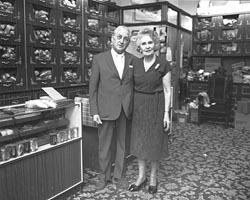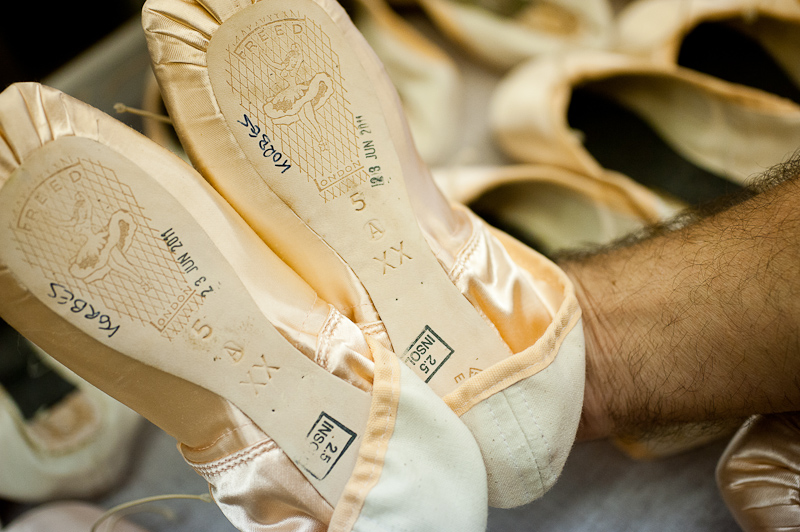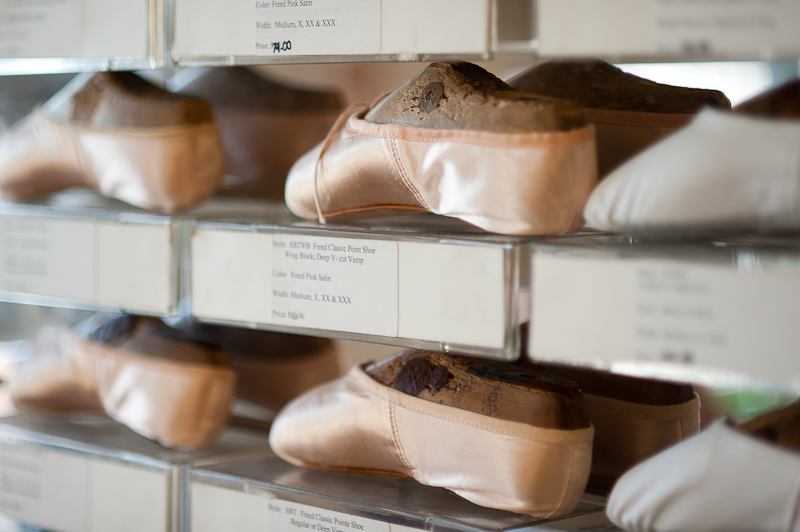In the late 1920’s, Frederick Freed left England’s leading pointe shoe manufacturer (along with his wife and one assistant) to set up shop in a small basement, making shoes of their own. Over time, his reputation for producing quality shoes increased, as did the demand for his shoes. This took the Freed brand to the forefront of the industry where it remains one of the most respected shoes among ballet dancers worldwide. Amazingly, after all these years The Freed of London Shop is still located at the same address.

There is something to be said for tradition.
Today over 250,000 pairs of Freeds are made every year, and they are sold in over 50 countries. Every one of them is hand-crafted by a Professional Pointe Shoe Maker, each of which makes between 30 and 40 pairs daily. Makers shape their shoes in a unique way and they are identified by their own personal stamp on the bottom of the shoe. Symbols include letters, a key, a heart and a Maltese Cross, among others.

Freeds are made using the “turn shoe” method where they are constructed inside-out, then turned to be completed. The “block” of the pointe shoe is made up of satin, burlap, layers of tissue paper, paper and hessian, and a paste that is comprised of flour, water and a few secret ingredients. Once made, the shoes are baked in an oven overnight at around 160 degrees (70 degrees C) so that they harden properly.
The Maker needs just three simple tools to fashion the shoe—a smooth hammer, a pair of long-nosed pliers and a broom handle. There are 7 different styles of stock pointe shoes in 4 widths, but since each is made by hand, there are really hundreds of variations. Two-thirds of the shoes are tailored to meet an individual dancer’s specifications.

There are approximately 20-30 cobblers working for the company at any given time, and one of them worked for Freed for 44 years before stepping down. As a matter-of-fact, isn’t uncommon for a Maker to work for Freed until retirement. You can take a closer look at the process of making Freeds on their site, where they have all of the steps outlined in full detail. It’s a fascinating process.
Join us here next week for a post that takes a look at how to fit Freed of London pointe shoes.
Thanks to Christopher Duggan for the photography in our Freed posts except where otherwise noted:

Contributor Christopher Duggan is the founder and principal photographer of Christopher Duggan Photography, a New York City-based wedding and dance photography studio. Duggan has been the Festival Photographer for Jacob’s Pillow Dance since 2006. In this capacity, and as a respected New York-based dance photographer, he has worked with renowned choreographers and performers of international acclaim as well as upstarts in the city’s diverse performance scene.
He has created studio shots of Gallim Dance, Skybetter + Associates and Zvidance, among others, and in 2011 alone, he has photographed WestFest at Cunningham Studios, Dance From the Heart for Dancers Responding to Aids, The Gotham Dance Festival at The Joyce Theater, and assisted Nel Shelby Productions in filming Vail International Dance Festival.
Duggan often teams up with his talented wife and Pillow videographer Nel Shelby (http://nelshelby.com). A New York City-based husband and wife dance documentation team, they are equipped to document performances, create and edit marketing videos and choreography reels, and much more.
Christopher Duggan Photography also covers Manhattan’s finest wedding venues, the Metropolitan and Tri-State areas, and frequently travels to destination weddings. The company’s mission is straightforward and heartfelt – create timeless, memorable images of brides, grooms, their families and friends, and capture special moments of shared love, laughter and joy.
His photographs appear in The New York Times, Destination I Do, Photo District News, Boston Globe, Financial Times, Dance Magazine, Munaluchi Bridal, and Bride & Bloom, among other esteemed publications and popular wedding blogs. One of his images of Bruce Springsteen was added to the Rock & Roll Hall of Fame’s celebrated photography collection in 2010. His company has been selected for inclusion in “The Listings” in New York Weddings magazine.





I LOVE reading about the various methods involved in making pointe shoes. They are one of the last of the handcrafted items in this automated world. Thanks!
So glad you liked this post! 🙂 You’re right…not much is left that is made by hand….unfortunately!
I wear Freeds and would love to visit the shop someday–can’t believe it’s still in the same place where it started!
I love Freeds! 🙂 I know–I’d love to see it too! Maybe we’ll have to use that as an excuse to go to London! 🙂
Wow, I didn’t know it was such a process, no wonder they cost so much! The pictures are so beautiful. I’ve never seen a pointe shoe that close up before. PRETTY!!
Thanks for the comment Lisa! Aren’t they pretty? Freeds are especially beautiful b/c of their coloring I think….